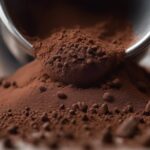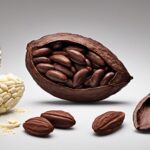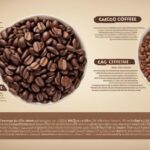Raw Food Ingredients
A Comprehensive Guide to Caffeine in Cacao
An exploration of the caffeine content in cacao, from fermentation to types like Forastero and Criollo, revealing surprises you didn't know – dive in!
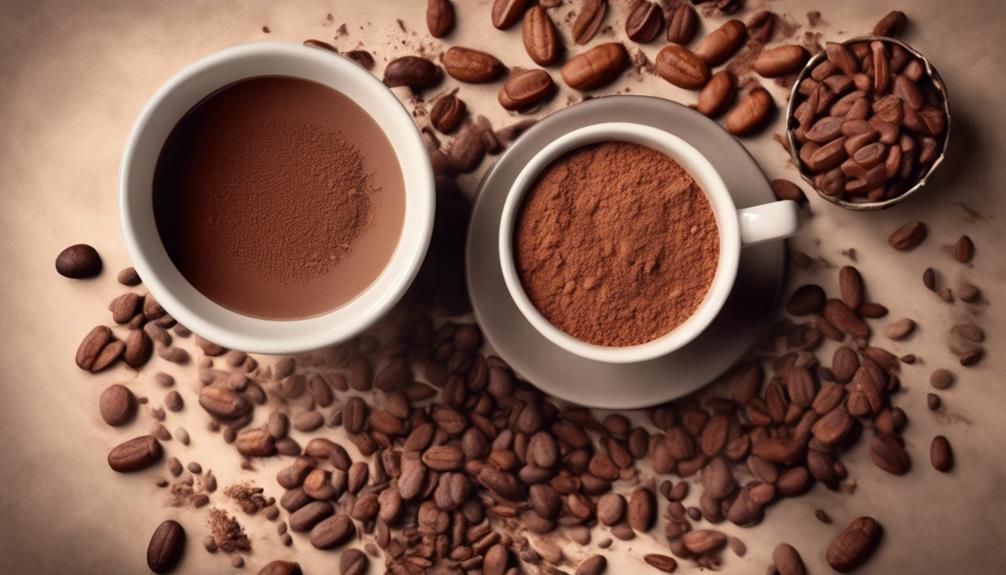
Cacao, which comes from cacao tree pods, undergoes a detailed process involving fermentation, roasting, and grinding to transform into chocolate. Varieties such as Forastero, Criollo, and Trinitario impact the overall caffeine content. Dark chocolate contains higher levels of caffeine compared to milk or white chocolate because of the added theobromine. Being aware of these differences can help with making informed decisions, particularly when it comes to health benefits and avoiding potential drawbacks.
Cocoa powder, a healthier option with natural fats and antioxidants, gives a subtle caffeine boost suitable even for the sensitive. Careful consideration of theobromine effects, differing from caffeine, is crucial, especially in darker chocolate. Embrace moderation within daily limits, keeping in mind individual tolerance, balanced consumption, and overall well-being. Recipes like a Mocha Smoothie or Cacao-Infused Chili can further enrich your cacao experience with caffeine.
Key Takeaways
- Dark chocolate contains higher caffeine and theobromine levels.
- Understand caffeine variances in cacao products for informed choices.
- Moderation in consumption for health benefits and avoiding negatives.
- Consider theobromine effects, especially in dark chocolate.
- Balance daily caffeine intake while enjoying cacao treats.
Origins of Cocoa Beans
Harvested from large pods on the cacao tree, cocoa beans are the seeds that form the basis of the beloved treat we all know as chocolate. These beans come in different varieties like Forastero, Criollo, and Trinitario, each contributing distinct flavors to the world of chocolate.
When the cacao pods are ready, they're carefully harvested to guarantee the quality of the beans inside. The next vital steps involve fermentation and the drying process. Fermentation helps to develop the rich chocolatey taste we love, while the drying process removes any bitter undertones, leaving behind the pure essence of cocoa.
It's fascinating to think about how these simple beans undergo such a transformation to become the delectable chocolate we enjoy. The care and precision that go into each stage of this process truly highlight the artistry behind the creation of chocolate.
Cacao Bean Processing Methods
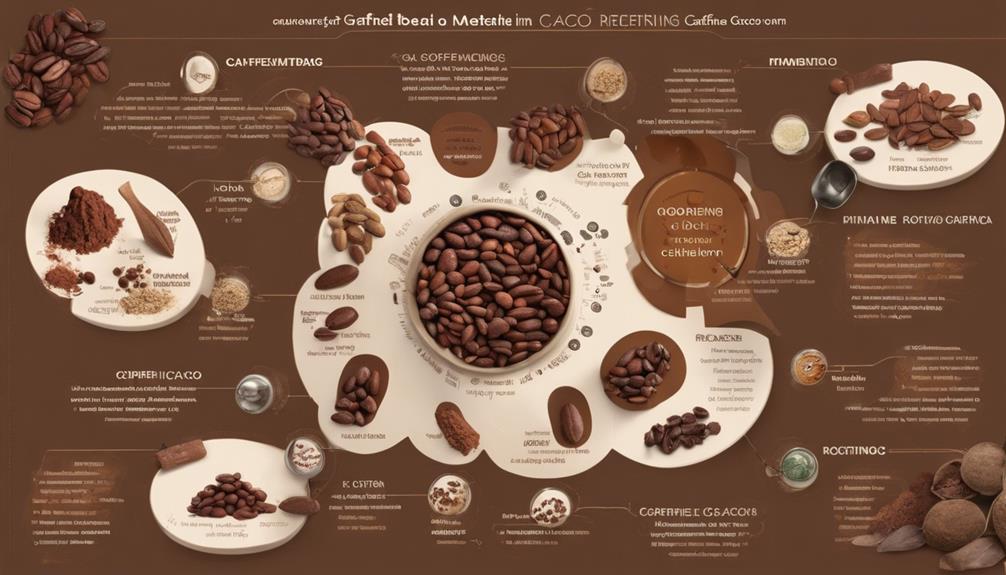
After the careful fermentation and drying of cacao beans to develop their rich flavors, the next essential step in the process involves roasting to enhance aroma and flavor profiles. Roasting cacao beans is a pivotal step that not only intensifies the flavors but also reduces the moisture content, leading to a more concentrated taste.
Once roasted, the beans are ground to create a smooth paste known as chocolate liquor. This liquor is then pressed to separate the cocoa solids from the cocoa butter, which is a key component in chocolate-making. Following this separation, the final processing stages include mixing, refining, and conching.
Conching is a process where the chocolate is continuously mixed and heated to achieve the desired texture and taste. Through these meticulous steps of grinding, pressing, and conching, the cacao beans transform into the delectable chocolate products we all love.
Caffeine Levels in Cocoa Products
Cocoa products, like baking cocoa and dark chocolate, contain varying levels of caffeine and theobromine. Dark chocolate tends to have higher amounts of both compared to milk or white chocolate.
It's important to be mindful of the levels of these stimulants in cocoa products for moderation and health purposes.
Cacao Vs. Coffee
When comparing cacao and coffee regarding caffeine levels in cocoa products, it is essential to note that dark chocolate contains more caffeine than milk or white chocolate due to its higher cocoa solid content. Theobromine, a compound similar to caffeine, is also present in cocoa nibs. Here is a comparison between the caffeine content in cacao products and coffee:
| Product | Caffeine Content (per 100g) | Theobromine Content (per 100g) |
|---|---|---|
| Dark Chocolate | High | High |
| Milk Chocolate | Moderate | Moderate |
| White Chocolate | Low | Low |
| Coffee | High | Low |
Understanding these differences can help in making informed choices between cacao and coffee consumption.
Dark Chocolate Comparison
Comparing the caffeine levels in dark chocolate to other cocoa products reveals its significantly higher content. Dark chocolate packs around 43mg of caffeine per 100g, surpassing milk chocolate in caffeine concentration.
Additionally, dark chocolate contains approximately 493mg of theobromine per 100g, a compound that's elevated in dark chocolate compared to milk or white chocolate.
The combined caffeine and theobromine content in dark chocolate might provide a mild stimulant effect when consumed. This stimulant effect sets dark chocolate apart from its milk and white counterparts, making it a popular choice for those seeking a bit of a pick-me-up.
Moderation and Health
With varying levels of theobromine and caffeine found in different cocoa products, it's essential to understand the importance of moderation for one's health.
- Consuming high amounts of theobromine and caffeine can have negative side effects on the body.
- Moderation is key to enjoying the health benefits of cocoa products without overloading on caffeine.
- Dark chocolate contains higher levels of theobromine and caffeine compared to milk chocolate.
- Balancing consumption of cocoa products can help prevent adverse health effects while still enjoying their rich flavors.
Health Benefits of Cocoa Powder
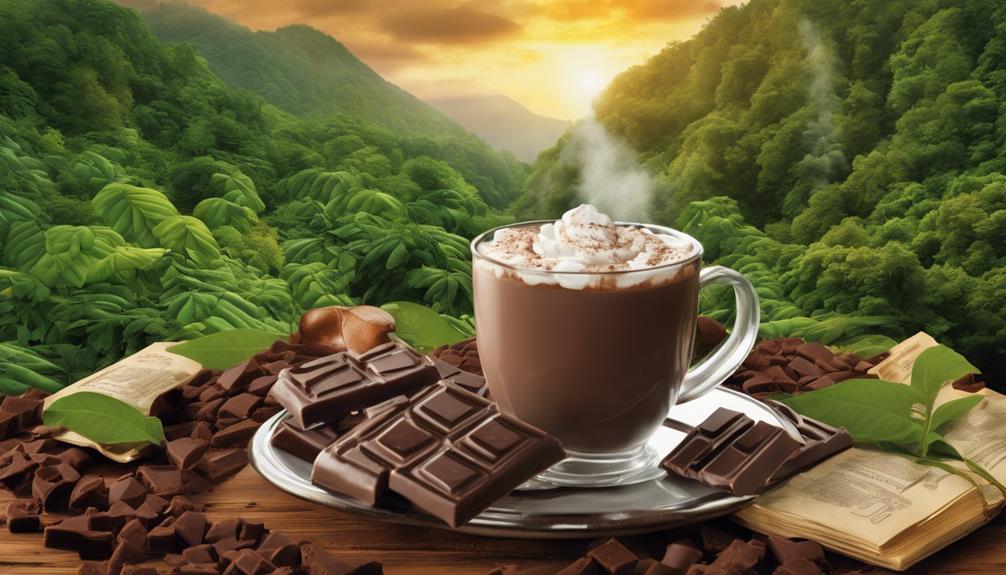
Indulging in cocoa powder not only satisfies my chocolate cravings but also offers a range of health benefits. Cocoa powder, derived from cacao beans, retains natural fats like cocoa butter that are removed during processing.
Despite its intense and rich chocolaty taste, cocoa powder contains no added sugars, making it a healthier alternative for fulfilling sweet cravings. Additionally, even a small amount, like a tablespoon of cocoa powder, can provide a subtle caffeine kick. Compared to other caffeinated beverages, cocoa powder offers a milder caffeine effect, making it a suitable choice for those sensitive to caffeine.
Beyond its delightful flavor and caffeine content, cocoa powder is packed with health benefits. These benefits include antioxidant properties, which can help reduce inflammation and improve heart health.
Comparing Caffeine in Chocolate Products
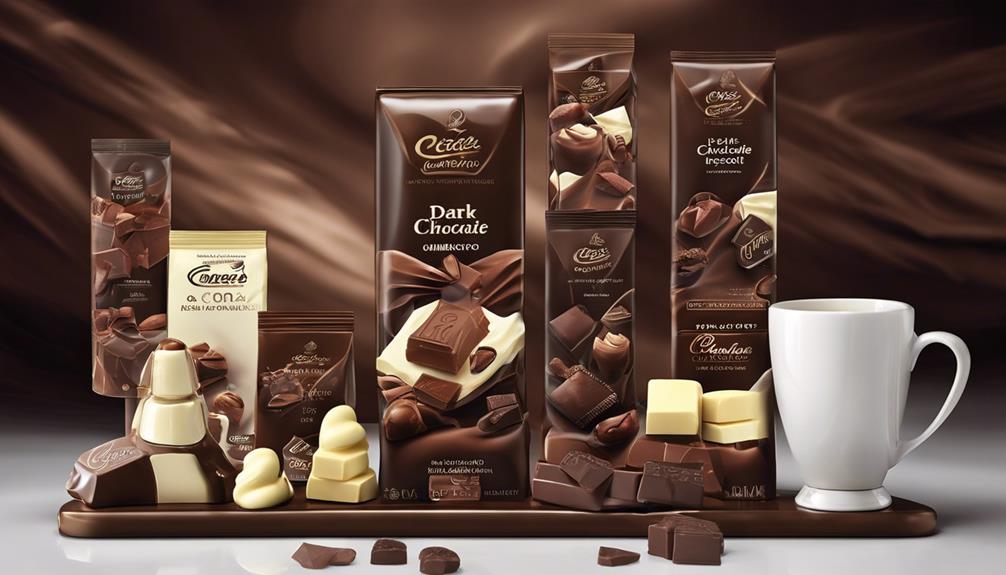
Savoring different chocolate products reveals varying levels of caffeine content, ranging from the energizing dark chocolate to the caffeine-free white chocolate. Here's a breakdown to help you understand better:
- Dark Chocolate: Contains around 43mg of caffeine per 100g, making it a good choice for a little pick-me-up during the day.
- Milk Chocolate: Offers approximately 20mg of caffeine per 100g, providing a milder energy boost compared to dark chocolate.
- Cacao Powder: Packs a punch with up to 230mg of caffeine per 100g, perfect for those needing a more significant caffeine kick.
- White Chocolate: For those looking to avoid caffeine altogether, white chocolate is the way to go as it doesn't contain any caffeine at all.
Understanding Theobromine in Cacao
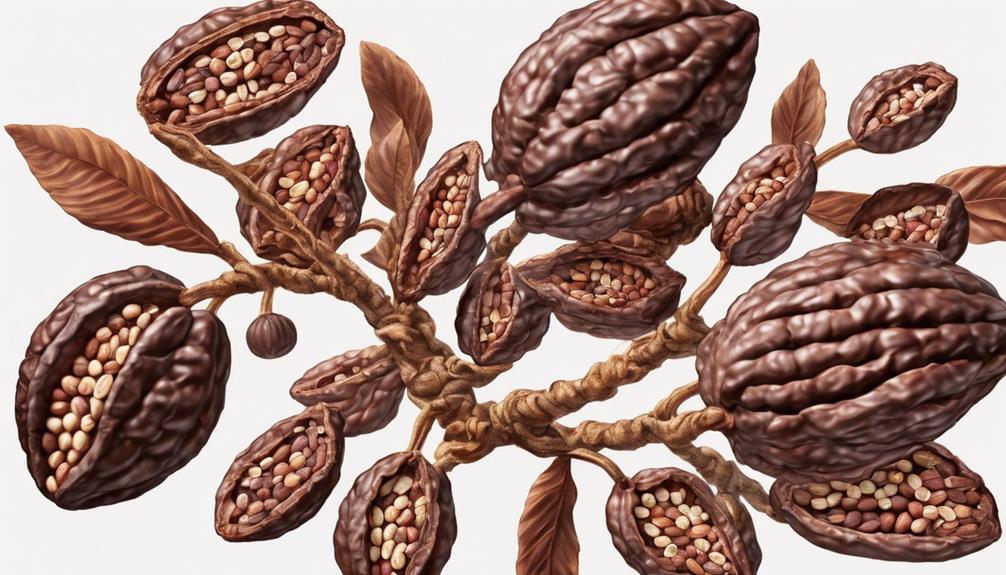
Exploring the world of cacao reveals not only varying levels of caffeine in different chocolate products but also the presence of theobromine, a stimulant found in cacao. Theobromine acts as a mild stimulant, dilating blood vessels to enhance oxygen flow throughout the body. Unlike caffeine, the effects of theobromine are longer-lasting, providing a sustained energy boost. However, consuming theobromine in moderation is crucial, as overconsumption can lead to side effects like nausea and an increased heart rate.
Dark chocolate and cocoa products contain higher levels of theobromine compared to milk chocolate, making them a more potent source of this stimulant. This compound is what gives dark chocolate its characteristic bitter taste. Pets are more susceptible to theobromine poisoning from consuming chocolate due to their slower metabolism. Understanding the effects of theobromine in cacao can help you make informed choices about your chocolate consumption for both yourself and your furry friends.
Caffeine in Dark Chocolate Vs. Milk Chocolate
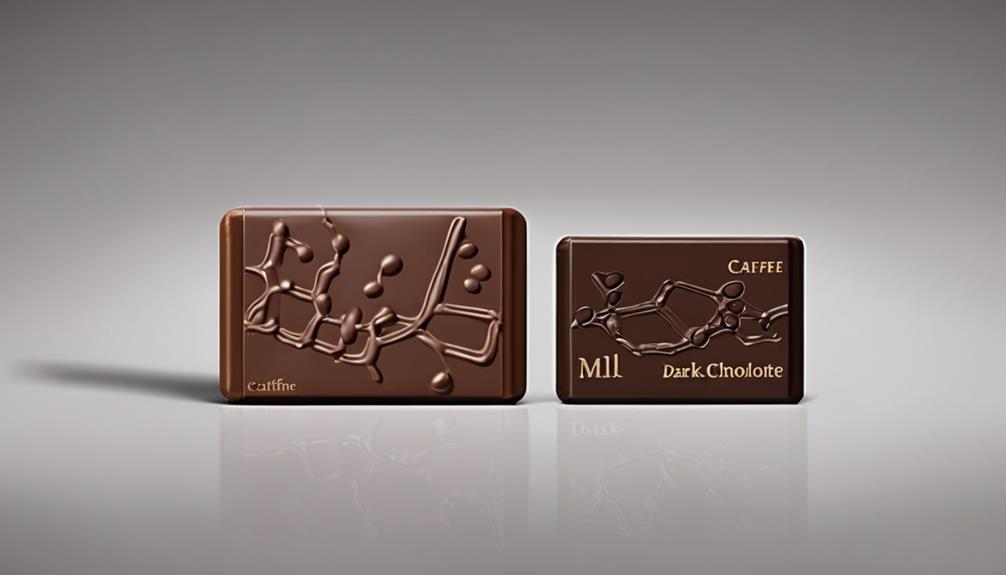
Comparing the caffeine content between dark chocolate and milk chocolate reveals a significant difference based on their cocoa concentrations. Here are four key points to bear in mind:
- Dark chocolate contains around 43mg of caffeine per 100g, while milk chocolate has approximately 20mg per 100g, making dark chocolate the higher caffeine option due to its increased cocoa content.
- The caffeine in dark chocolate can offer a mild stimulant effect, providing a subtle energy boost compared to milk chocolate.
- In contrast, milk chocolate has lower caffeine levels, making it a gentler choice for individuals with caffeine sensitivity.
- Understanding the disparities in caffeine content between dark and milk chocolate can help in making informed decisions based on personal preferences and caffeine tolerance levels. By being aware of these differences, individuals can select the type of chocolate that aligns best with their desired caffeine intake.
Effects of Caffeine on the Body
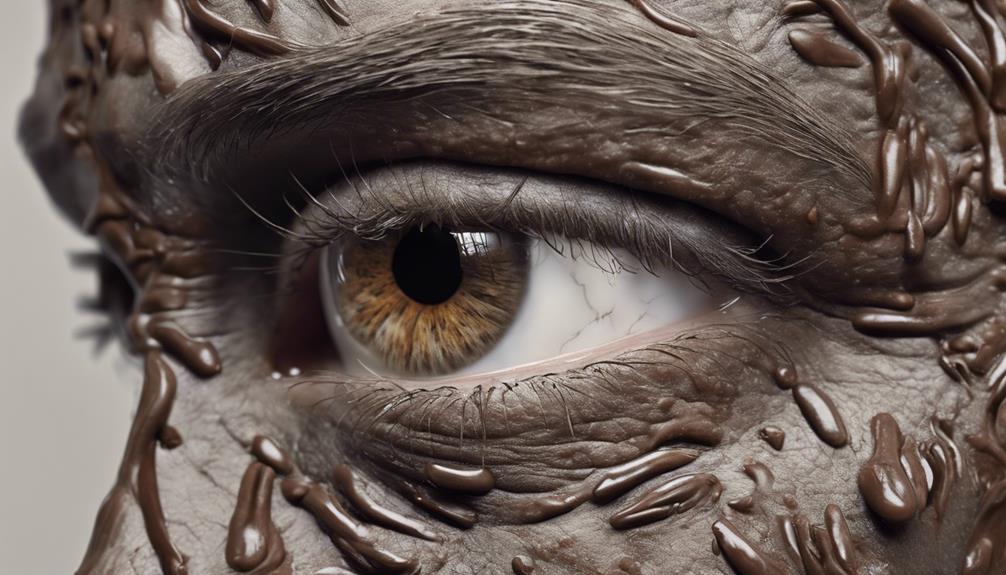
After understanding the disparities in caffeine content between dark and milk chocolate, it's crucial to recognize the varied effects caffeine can have on the body. When it comes to caffeine in chocolate, dark chocolate contains higher levels of caffeine compared to milk chocolate. This means that indulging in dark chocolate can pack more of a caffeine punch. Caffeine, found in both types of chocolate along with theobromine, acts as a psycho-stimulant on the central nervous system. It can lead to feelings of alertness, but in some individuals, it may also trigger anxiety and jitteriness.
Consuming an excessive amount of caffeine, exceeding 400mg per day, can result in unpleasant side effects such as headaches and jitters. Additionally, caffeine is a diuretic, which means it can disrupt sleep patterns if consumed late in the day. It's important to be mindful of your caffeine intake, as it can deplete magnesium stores in the body over time. So, enjoy your chocolate treats in moderation to savor the benefits without overindulging in caffeine's effects.
Recommended Consumption of Caffeinated Cacao

When relishing caffeinated cacao products, it's crucial to keep tabs on your intake. Moderation is key to staying within the recommended daily caffeine limits.
Be mindful of the caffeine content in different cacao treats to maintain a balanced consumption level.
Optimal Caffeine Intake
To optimize my caffeine intake while enjoying caffeinated cacao, I adhere to the recommended daily limit of up to 400 milligrams for most adults. Here are four essential tips to help you make the most of your caffeinated cacao experience:
- Enjoy dark chocolate for a more concentrated cocoa flavor and potential caffeine boost.
- Be mindful of your consumption of caffeine-containing cacao products like hot chocolate.
- Remember that theobromine, another stimulant in cacao, can also impact your overall caffeine intake.
- Consider your individual tolerance to caffeine when indulging in delicious caffeinated cacao treats.
Health Considerations for Cacao
Taking into account the health implications of consuming caffeinated cacao, it's essential to understand the recommended intake for ideal well-being. Moderation is key when enjoying cacao for its caffeine and theobromine content.
Dark chocolate and cocoa products can offer benefits like enhanced mood and cognitive function, as well as sustained energy levels without the usual caffeine jitters. It's important to balance consumption to avoid potential side effects like heart palpitations from excessive theobromine intake.
Recipes Using Caffeinated Cacao
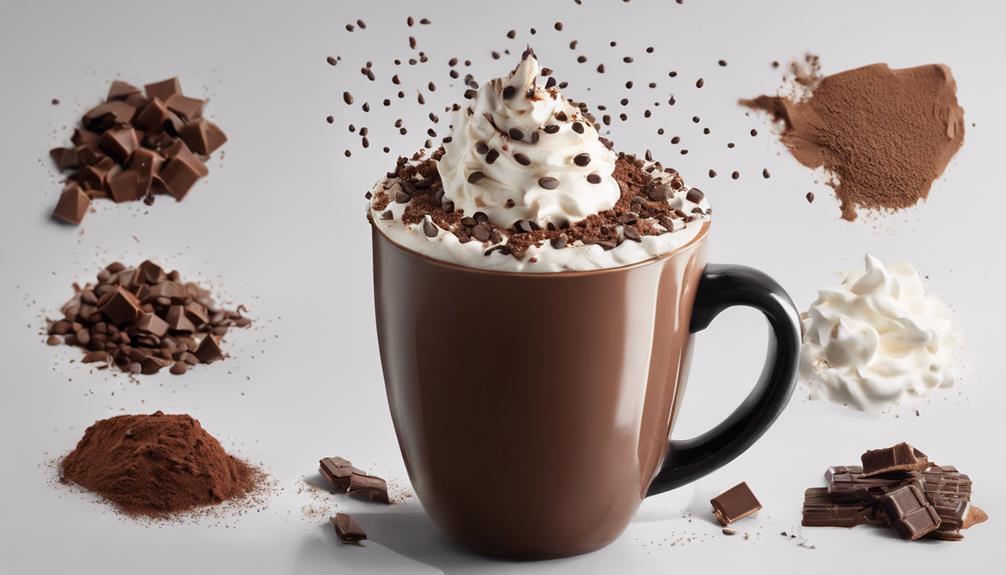
I've discovered some fantastic ways to incorporate the energizing power of cacao into delicious recipes. Here are four recipes that will surely satisfy your cravings and boost your energy levels:
- Mocha Smoothie: Blend dark chocolate cacao with coffee for a creamy and energizing morning treat.
- Cacao Energy Balls: Mix dates, nuts, and cacao for a quick and healthy snack bursting with flavor and caffeine.
- Cacao Espresso Martini: Combine cacao with espresso and spirits for a luxurious and invigorating cocktail experience.
- Cacao-Infused Chili: Spice up your chili recipe by adding cacao and beans for a unique and savory dish that packs a caffeine punch.
These recipes not only provide a delicious way to enjoy the benefits of cacao but also offer a delightful caffeine kick to keep you going throughout the day. Try them out and indulge in the rich flavors and energizing effects of cacao in your meals.
Frequently Asked Questions
How Much Caffeine Is in Pure Cacao?
In pure cacao, the caffeine content ranges from 0.1% to 0.7%. Cacao powder has a higher concentration, up to 230mg per 100g. Dark chocolate from cacao contains about 43mg per 100g. White chocolate has no caffeine.
How Much Caffeine Is in 70 Percent Cacao?
I've found that a 70% cacao dark chocolate bar typically holds 25-30 milligrams of caffeine per 1-ounce serving. It's a moderate caffeine source compared to coffee. Theobromine content is higher, contributing to its stimulant effects.
Is There More Caffeine in Cacao Than Coffee?
Regarding caffeine content, cacao generally has less than coffee. Dark chocolate or cocoa powder offers a milder stimulant effect compared to coffee due to lower caffeine levels. The contrast regarding caffeine content between cacao and coffee is notable.
Is There Caffeine in Full Power Cacao?
Yes, there's caffeine in Full Power Cacao. It provides a natural energy boost, enhances alertness, focus, mood, cognitive function, and mental clarity. With approximately 230mg per 100g, Full Power Cacao is a great source of caffeine!
Which has more caffeine, cacao or coffee?
When it comes to cacao vs coffee comparison points, it’s important to note that coffee generally contains more caffeine than cacao. A typical cup of coffee has around 95 mg of caffeine, while a cup of cacao has about 12-20 mg. So, if you’re looking for a caffeine boost, coffee is your best bet.
Conclusion
In the world of cacao, caffeine plays an essential role in providing energy and focus. Just like a superhero harnesses their powers to save the day, caffeine in cacao can help you stay alert and ready for any challenge that comes your way.
So next time you enjoy a piece of chocolate or sip on a cup of hot cocoa, remember the caffeine content and embrace the boost it gives you!
Rachael, the Editor in Chief of RachaelsRawFood.com, is an inspiring and passionate individual who has dedicated her life to promoting the benefits of a raw food lifestyle. Known for her vibrant and energetic personality, Rachael has built a strong online presence that has transformed her personal journey into a thriving community of raw food enthusiasts.
Raw Food Ingredients
Inside a Cacao Ceremony
Mystical and transformative, a cacao ceremony unveils ancient rituals for spiritual growth and inner connection – dive deeper into its enchanting world.
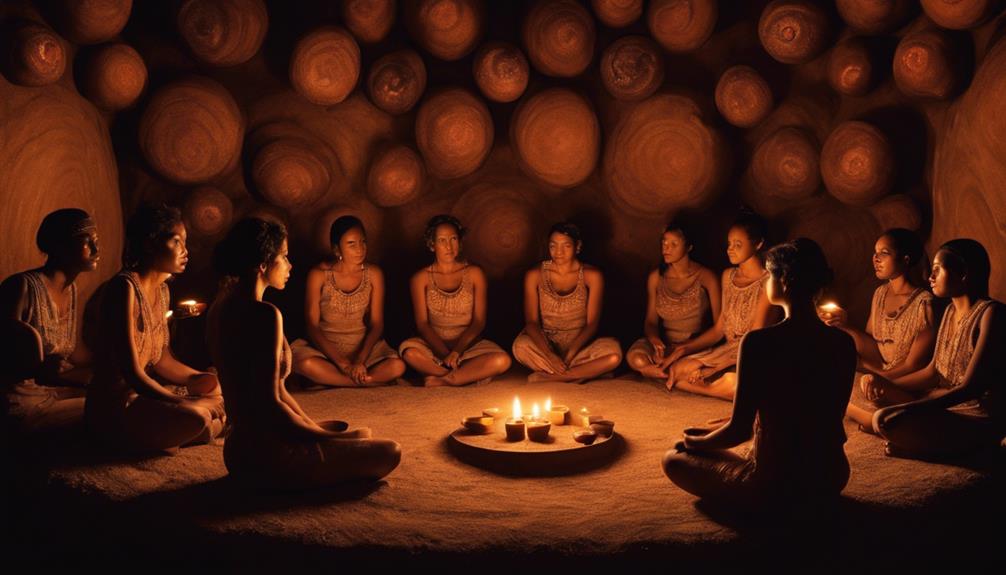
In a cacao ceremony, we engage in a sacred ritual where we consume ceremonial-grade cacao to expand our consciousness and support spiritual development. This practice originates from Mayan and Aztec cultures, where cacao was revered as a sacred offering and a tool for spiritual progress. Through drinking ceremonial cacao, we tap into ancient traditions and concentrate on setting intentions, showing gratitude, and cultivating a sacred environment. This elixir unlocks our hearts, uplifts our spirits, and improves our overall well-being.
Crafting a tranquil setting and being mindful during the ceremony are key aspects that allow us to deeply connect with the cacao's energy and foster self-awareness. Embrace the experience to uncover more about the wonders of a cacao ceremony.
Key Takeaways
- Start by drinking ceremonial-grade cacao for elevated consciousness.
- Set intentions and express gratitude for a sacred experience.
- Create a tranquil space with intention and care.
- Engage in practices like breathwork and meditation.
- Connect deeply with cacao's energy for self-awareness.
Origins of Cacao Ceremony
The origins of the Cacao Ceremony trace back to the ancient Mayan and Aztec cultures in Central America. These indigenous communities viewed cacao not just as a beverage but as a sacred gift from the gods, using it in ceremonial practices to enhance spiritual growth and forge a deeper divine connection. The Ceremonial Cacao Ceremony was a revered ritualistic tradition that played a pivotal role in Mayan and Aztec societies, with the elite members using ceremonial-grade cacao for its health benefits and mystical properties.
Drinking ceremonial cacao was believed to elevate consciousness, open the heart, and create a sense of unity among participants. The practice of engaging in a Cacao Ceremony wasn't merely about consuming a beverage; it was a profound experience that intertwined physical, mental, and spiritual aspects. Through honoring the ancient Mayan and Aztec traditions, modern cacao ceremonies continue to offer individuals a space for introspection, healing, and connection with something greater than themselves.
Rituals and Traditions
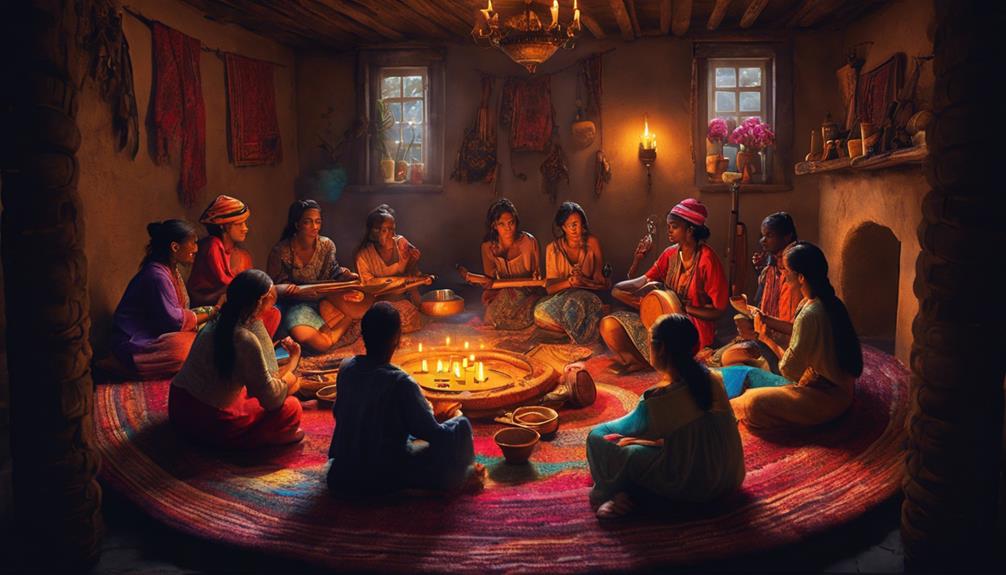
Exploring the rich tapestry of rituals and traditions in Ceremonial Cacao ceremonies reveals a profound connection to ancient practices and spiritual experiences. In these ceremonies, we honor the cacao spirit by starting with a ceremonial-grade cacao drink, allowing us to connect deeply with the plant's energy.
Traditional rituals often involve setting intentions, expressing gratitude for the cacao's gifts, and sharing personal growth aspirations. The focus is on creating a sacred space where emotional exploration and spiritual connection can flourish.
Practices like breathwork, meditation, and sharing experiences are common, enhancing our connection with cacao and facilitating a deeper understanding of ourselves. By engaging in these rituals, we open ourselves up to the transformative power of cacao and create a space for introspection and growth within the ceremony.
It's a beautiful journey of self-discovery and connection to the ancient traditions surrounding this sacred plant.
Benefits of Cacao Consumption
Revealing the benefits of consuming cacao uncovers a wealth of advantages for both physical and mental well-being. Ceremonial cacao, long revered in ancient cultures, isn't just a delightful treat but also a heart-opening elixir that can deepen one's spiritual practice. This sacred drink contains compounds like PEA, known for boosting mood, serotonin for happiness, and theobromine for energy. By partaking in ceremonial cacao, we connect with a tradition that goes beyond mere consumption; it becomes a ritual that helps us explore our inner selves.
Moreover, the antioxidants present in cacao offer protection to our bodies, supporting overall health. Regular cacao consumption can also have a positive impact on cardiovascular health, reducing the risk of chronic diseases. Embracing ceremonial cacao as an energy source can lead to improved mood, heightened energy levels, and enhanced overall well-being. So, next time you sip on ceremonial cacao, remember you're not just drinking a beverage; you're engaging in a practice that nurtures both body and soul.
Creating Sacred Space
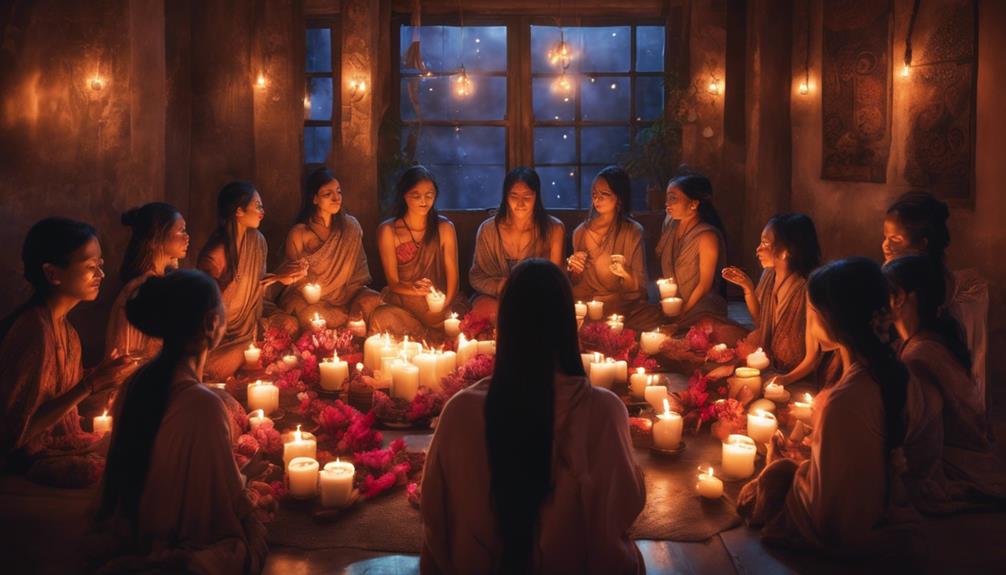
Crafting a tranquil atmosphere is crucial for a profound Cacao ceremony experience. As we prepare for the ceremony, establishing a sacred space becomes a sacred practice in itself. By arranging the space with intention and care, we honor the ceremonial tradition and invite the energy of the heart-opening Cacao into our midst. Here is a guide to help you in setting up your sacred space for the ceremony:
| Sacred Space Elements | Purpose |
|---|---|
| Candles | Create a cozy ambiance |
| Crystals | Enhance the energy flow |
| Sacred Objects | Connect to spiritual dimension |
Mindfulness During Ceremony
During the cacao ceremony, staying present in the moment is essential for experiencing its full benefits. To truly engage in mindfulness during the ceremony, one should:
- Connect Deeply: By being fully present, you can connect deeply with the cacao's energy and intention, allowing it to work its magic on your mind and body.
- Observe Thoughts: Mindfulness enables you to observe thoughts, emotions, and sensations that arise during the ceremony without judgment, fostering self-awareness and understanding.
- Enhance Sensory Experience: Being fully present enhances the sensory experience of drinking ceremonial cacao. It encourages focused attention on the rituals involved in preparing and consuming the cacao, amplifying the sensations it evokes.
Frequently Asked Questions
What's Involved in a Cacao Ceremony?
In a cacao ceremony, we set intentions, drink ceremonial-grade cacao, engage in meditation and breathwork, and share insights. It's about connecting with the spirit of cacao for growth and healing, fostering a deep sense of community.
What Do You Wear to a Cacao Ceremony?
I dress in loose, breathable clothing, often in white or light colors, for a cacao ceremony. Layers help with temperature changes. Going barefoot connects me with the Earth. Comfort is key for movement and relaxation.
What Do You Say in a Cacao Ceremony?
In a cacao ceremony, I express gratitude, set intentions, and share insights. My words create a sacred space for connection, healing, and transformation. I speak from the heart, honoring the cacao, nature, community, and our reciprocity with the Earth.
Who Should Not Do Cacao Ceremony?
If you have heart issues, hypertension, are on MAOIs, certain meds, pregnant, breastfeeding, or have caffeine sensitivity or allergies to cacao, it's best to avoid cacao ceremonies. Always consult a healthcare provider for guidance.
Can I Host My Own Cacao Ceremony at Home?
Yes, you can host your own cacao ceremony at home with ceremonial cacao near me. Simply source high-quality ceremonial cacao from a trusted provider. Set the space, create intentions, and prepare the cacao in a sacred manner. Invite friends and loved ones to experience the healing and heart-opening properties of this ancient plant medicine.
Conclusion
To summarize, participating in a cacao ceremony can be a transformative experience, allowing you to connect with yourself and the world around you in a deeper way. Just like a seed planted in fertile soil, the cacao ceremony nurtures your inner growth and brings forth new insights and understanding.
So, next time you have the opportunity to partake in a cacao ceremony, embrace it wholeheartedly and let the magic of this ancient tradition guide you on your journey of self-discovery.
Rachael, the Editor in Chief of RachaelsRawFood.com, is an inspiring and passionate individual who has dedicated her life to promoting the benefits of a raw food lifestyle. Known for her vibrant and energetic personality, Rachael has built a strong online presence that has transformed her personal journey into a thriving community of raw food enthusiasts.
Raw Food Ingredients
Sponge Cake Vs Regular Cake: Spotting 7 Key Differences
Yearning to uncover the subtle nuances between sponge cake and regular cake? Discover 7 key differences that will transform your baking game.
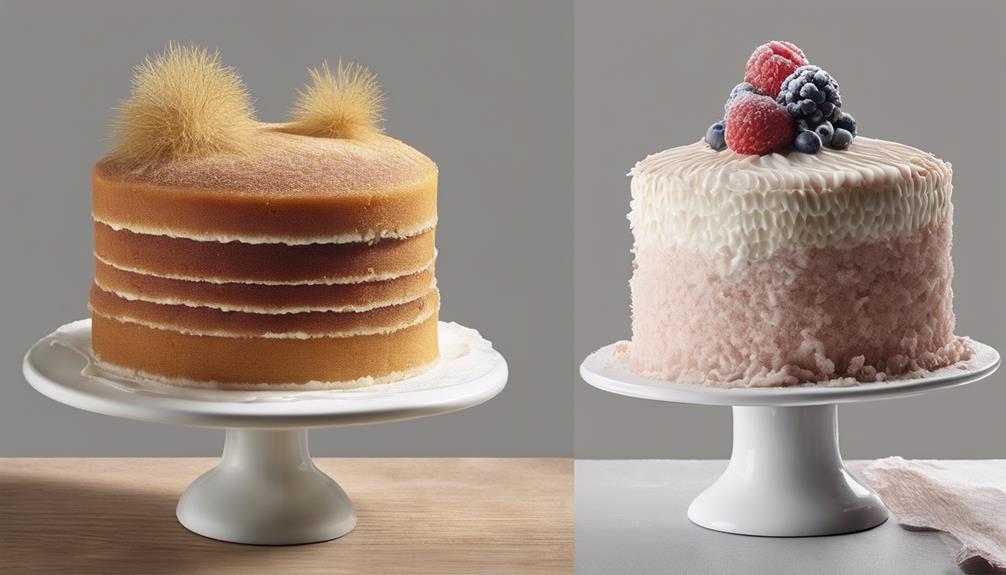
When comparing sponge cake to regular cake, it’s important to note seven key differences. Firstly, sponge cakes have a higher ratio of eggs to flour, while regular cakes include butter or oil for a richer flavor. Secondly, sponge cakes have a light, easily crumbled texture with more air, while regular cakes are denser and firmer. Thirdly, sponge cakes offer a delicate, less sweet taste compared to the sweeter flavor of regular cakes. Fourthly, the lower protein content in cake flour gives sponge cakes a tender crumb, while all-purpose flour in regular cakes results in a denser texture. Fifthly, butter adds richness to regular cakes, while sugar is necessary for the light structure of sponge cakes. Sixthly, sponge cakes have a light and airy crumb structure, whereas regular cakes have a denser one.
Lastly, sponge cakes pair well with lighter frostings like whipped cream, while regular cakes complement heavy frostings like buttercream. To uncover more about these distinctions, further exploration will reveal additional insights.
Key Takeaways
- Sponge cakes use a higher ratio of eggs to flour for a light, airy texture.
- Regular cakes contain butter or oil, resulting in a denser, richer texture.
- Sponge cakes have a delicate, less sweet flavor compared to regular cakes.
- Cake flour is used in sponge cakes for a tender crumb, while regular cakes use all-purpose flour.
- Frosting choice varies; sponge cakes pair well with lighter frostings, while regular cakes suit richer ones.
Ingredients Variations
When comparing sponge cake to regular cake, the key difference in ingredients lies in their fat content and ratio of eggs to flour. Sponge cakes, unlike regular cakes, contain a higher ratio of eggs to flour. This difference in composition affects the overall texture and taste of the cakes.
Regular cakes typically include butter or oil as a fat component, contributing to a richer taste and denser texture. In contrast, sponge cakes rely on the air whipped into the eggs for structure, resulting in a lighter, delicate crumb structure.
The method used to incorporate ingredients is also distinct between the two types of cakes. While fat is creamed with sugar in regular cakes to create a moist and tender crumb, sponge cakes achieve their airy and fluffy consistency through the incorporation of whipped eggs.
These several factors in ingredient composition and method used play a significant role in defining the unique characteristics of both cake varieties.
Texture Contrasts
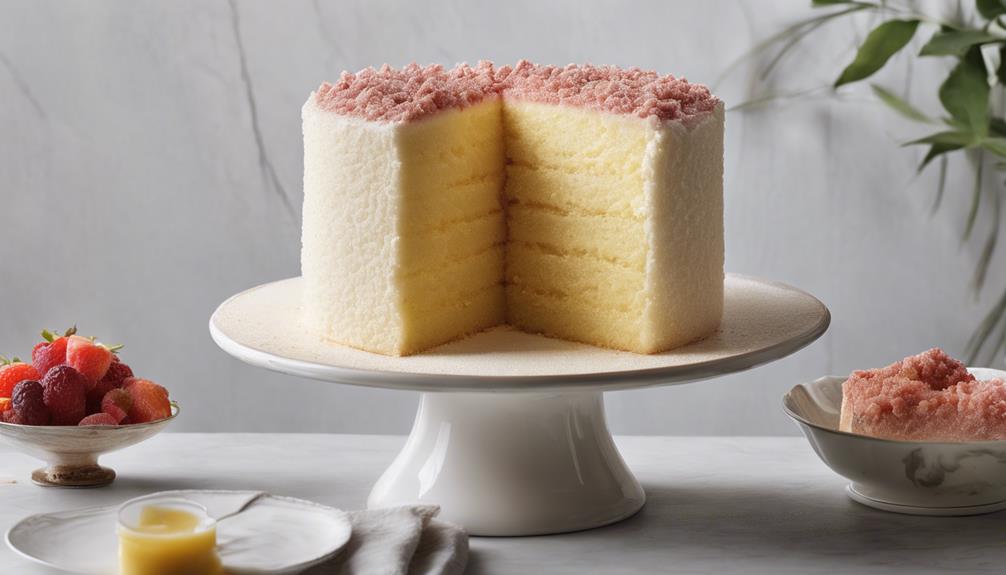
When comparing sponge cake to regular cake, one key difference lies in their texture contrasts. Sponge cakes are known for their light, easily crumbled texture that contains a large amount of air.
In contrast, regular cakes have a denser, more solid texture with less air incorporated into the batter.
Sponge Vs Regular Texture
Comparing the texture of sponge cakes to regular cakes reveals a distinct contrast in their density and crumb structure. Sponge cakes have a light and airy texture, achieved by incorporating a high amount of air into the cake batter when mixing eggs and sugar. On the other hand, regular cakes, such as butter or pound cakes, have a denser and firmer texture compared to sponge cakes. The table below summarizes the key differences in texture between sponge cakes and regular cakes:
| Aspect | Sponge Cakes | Regular Cakes |
|---|---|---|
| Density | Light and airy | Denser and firmer |
| Crumb Structure | Delicate and tender | Heavier and more compact |
| Leavening Agents | No leavening agents used | Baking powder or baking soda is used |
Moisture Levels Compared
Exploring the contrast in moisture levels between cakes and sponges reveals distinctive textural differences influenced by their unique compositions. When it comes to texture, moisture plays a vital role in determining the overall feel of the cake or sponge in your mouth. Here are four key points to keep in mind:
- Cakes become denser over time as they lose moisture, resulting in a firmer texture.
- On the other hand, sponges maintain a light and fluffy texture due to their high air content and moisture retention.
- The moisture levels in cakes contribute to their denseness, while sponges rely on moisture to stay airy.
- Understanding how moisture affects texture is essential for distinguishing between the dense nature of cakes and the airy feel of sponges.
Flavor Profiles
In sponge cakes, the flavor profile tends to be more delicate and less sweet compared to regular cakes. Sponge cakes focus on a light, airy texture that complements the subtle flavor profile, making them perfect for those who enjoy a less sugary treat. On the other hand, regular cakes, like white cakes, often taste sweeter due to the use of whole eggs or yolks, giving them a richer taste overall. The difference in flavor between these two types of cakes is influenced by various factors such as the amount of sugar, the type of flour used, and the fats incorporated into the recipe.
Let's break down the flavor profiles of sponge cakes and regular cakes in a simple table:
| Aspect | Sponge Cakes | Regular Cakes |
|---|---|---|
| Sweetness | Less sweet | Sweeter |
| Texture | Light and airy | Rich and dense |
| Flavor | Delicate, subtle | Bold and rich |
Cake Flour Usage
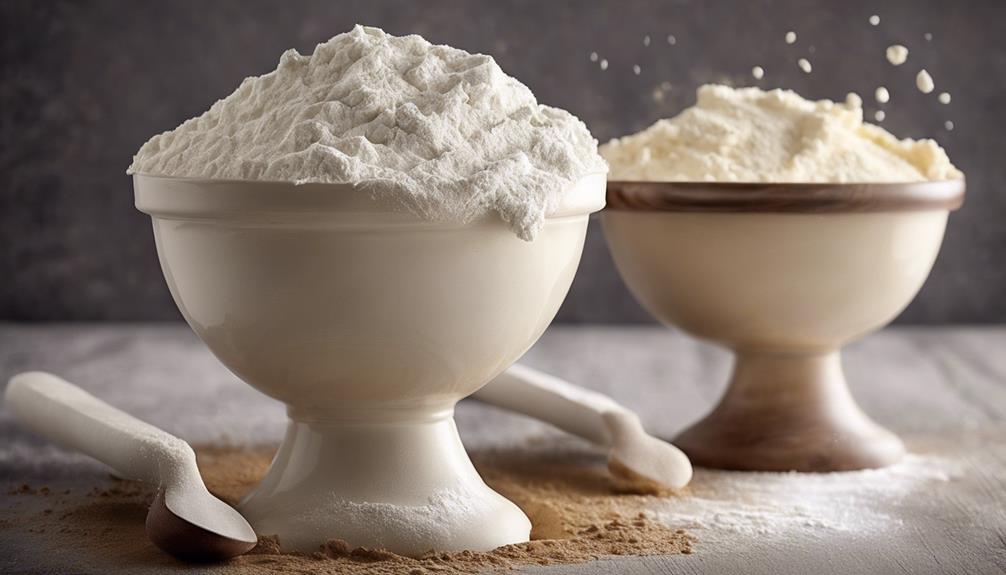
Cake flour and all-purpose flour differ in protein content, which is important for texture. Cake flour's lower protein levels yield a tender crumb in sponge cakes.
This impacts the cake's taste and texture significantly.
Flour Types Comparison
Choosing cake flour in sponge cakes plays an essential role in their distinctive delicate and soft texture due to its low protein content. When comparing flour types for cakes, here's why cake flour stands out for sponge cakes:
- Light and Airy Texture: Cake flour's low protein content helps create a light and airy texture in sponge cakes.
- Tender Crumb Structure: The low protein content in cake flour prevents gluten formation, resulting in a tender crumb structure.
- Delicate Softness: Sponge cakes require cake flour to achieve a delicate and soft texture that differs from regular cakes.
- Fine-textured Crumb: Cake flour is finely milled and bleached, producing a fine-textured crumb that enhances the overall quality of sponge cakes.
Texture Differences Explained
With its low protein content, cake flour contributes greatly to the delicate and airy texture that sets sponge cakes apart from regular cakes. The lower protein content in cake flour plays an important role in creating a tender crumb structure in sponge cakes, giving them that light and fluffy quality.
Regular cakes, on the other hand, typically use all-purpose flour, which results in a denser texture compared to sponge cakes. The soft and airy quality that defines sponge cakes is largely attributed to the use of cake flour.
Impact on Taste
When using cake flour in baking, the subtle difference in texture can greatly influence the overall taste experience of the finished product.
- Cake flour in sponge cakes contributes to a lighter texture and finer crumb structure.
- Regular cakes using all-purpose flour tend to have a denser texture compared to sponge cakes.
- Sponge cakes made with cake flour have a delicate, tender mouthfeel.
- The use of cake flour in sponge cakes enhances the overall softness and sponginess of the cake.
Butter Vs. Sugar
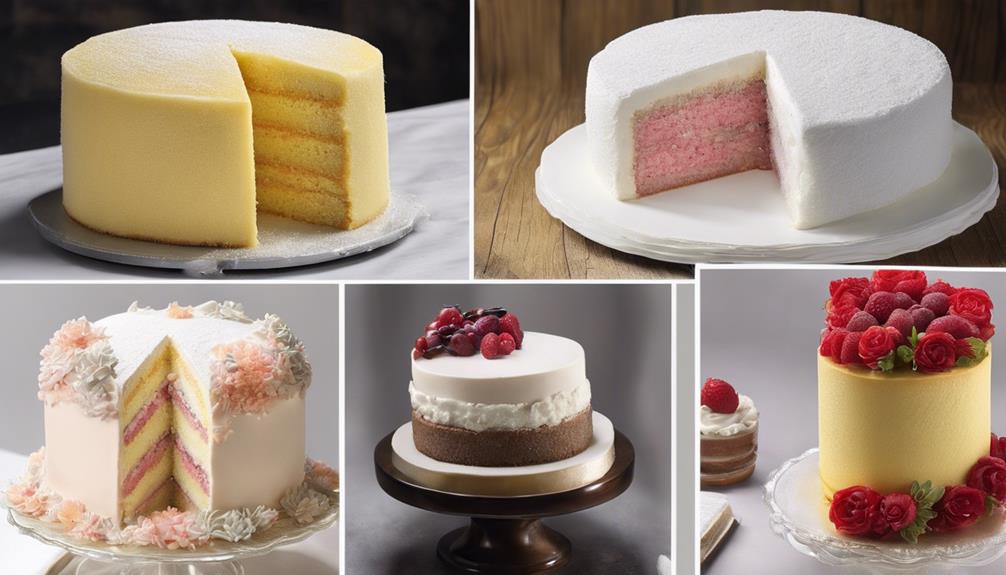
Considering the key ingredients in sponge cake versus regular cake, the balance between butter and sugar plays a critical role in determining their distinct textures. Butter provides richness and moisture in regular cakes, leading to a denser texture due to its higher quantity. On the other hand, sugar is vital in sponge cakes, contributing to their light and airy structure.
To better understand how butter and sugar impact the characteristics of these cakes, let's compare their ratios in the table below:
| Aspect | Regular Cake | Sponge Cake |
|---|---|---|
| Butter | Higher amount | Lower amount |
| Sugar | Moderate amount | Higher amount |
| Texture | Denser | Light and airy |
The ratio of butter to sugar significantly varies between regular and sponge cakes, influencing not only the taste but also the overall texture. By grasping the interplay between these ingredients, one can distinguish between the unique qualities of sponge cakes and regular cakes.
Crumb Structure Differences
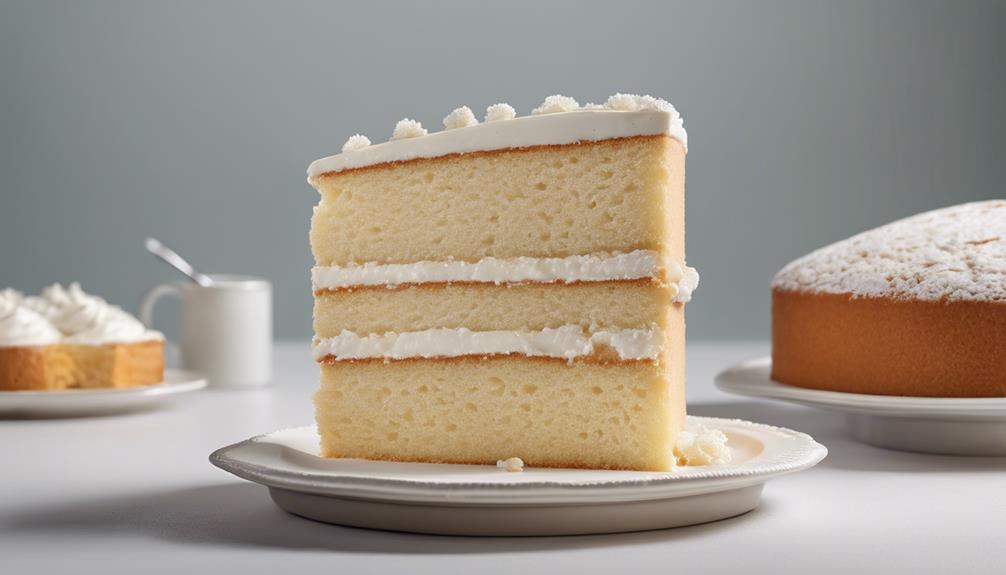
In understanding the nuances of cake textures, the crumb structure plays a pivotal role in distinguishing between sponge cakes and regular cakes. Here are some key differences to note:
- Light and Airy Crumb: Sponge cakes achieve a light and airy crumb structure by incorporating air from whipped eggs and sugar, resulting in a fluffy texture.
- Denser Crumb Structure: Regular cakes, such as white cakes, have a denser and firmer crumb structure with tighter, neater crumbs that offer a more substantial mouthfeel.
- Fluffy and Delicate: The crumb of a sponge cake is delicate, giving it a less dense texture compared to regular cakes, which can be more compact.
- Leavening Agents: Regular cakes often rely on baking powder or soda for leavening, contributing to their specific crumb structure and overall density.
Understanding these distinctions in crumb structure can help you identify the type of cake you're enjoying or aiming to bake.
Frosting Compatibility
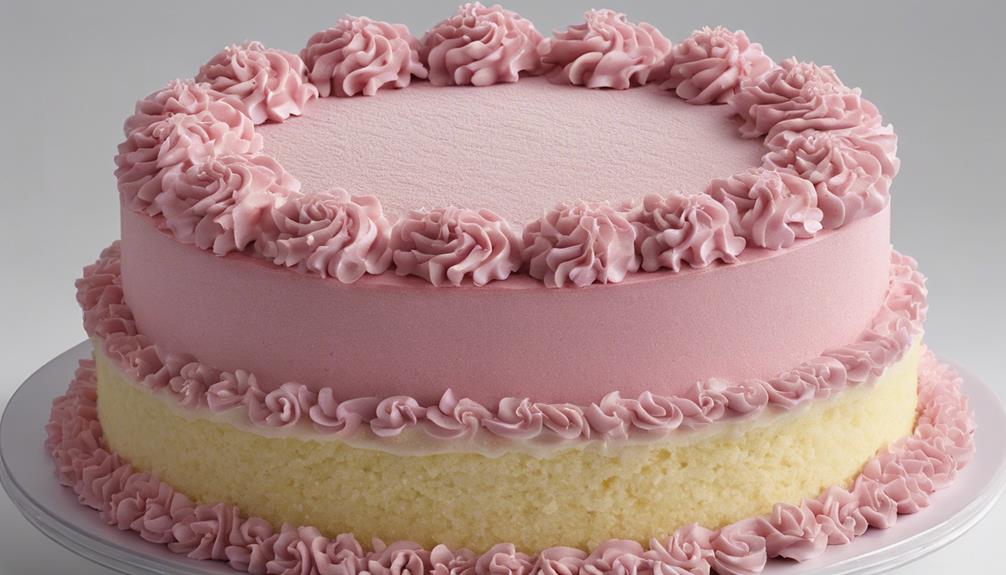
Exploring how different types of frosting complement the textures of sponge cakes and regular cakes reveals distinctive pairings that enhance the overall dessert experience. Sponge cakes, with their light and airy crumb structure, are best paired with lighter frostings like whipped cream or fruit-based options. These frostings complement the delicate texture of sponge cakes without overpowering them, creating a vital balance of flavors and textures.
On the other hand, regular cakes, known for their denser texture, pair well with heavier frostings such as buttercream or cream cheese. These richer frostings provide a decadent contrast to the sturdy structure of regular cakes, adding depth and richness to each bite.
When it comes to layered cakes, the lightness of sponge cakes makes them an ideal choice for multiple fillings and frostings. Their delicate nature allows for different flavors and textures to shine through in each layer. Regular cakes, with their sturdier composition, can withstand the weight of elaborate decorations and fondant, making them a popular choice for intricately designed cakes.
Choosing the right frosting for your cake plays an essential role in enhancing both the taste and presentation, ensuring a delightful dessert experience.
Frequently Asked Questions
What Is the Difference Between Regular Cake and Sponge Cake?
The difference between regular cake and sponge cake is that sponge cake contains no fat, giving it a light, fluffy texture. Regular cake, on the other hand, has added fats like butter or oil, resulting in a denser consistency.
What Are the 7 Types of Cakes?
Sure thing! There are 7 types of cakes, each with distinct flavors and textures. From rich butter cake to light angel food cake, they offer a range of delicious experiences. Exploring these varieties can truly enrich your baking adventures.
How Do Sponge Cakes Differ From Other Shortened Cakes?
When considering sponge cakes versus other shortened cakes, the key distinction lies in their fat content. Sponge cakes skip the fats, relying on eggs and sugar for structure, resulting in a delicate, airy texture different from richer counterparts.
What Is Unique About a Sponge Cake?
When I savor a slice of sponge cake, I'm struck by its airy lightness and delicate crumb. The magic lies in the whipped eggs and sugar, creating a fluffy texture unique to sponge cakes.
What Are the Key Differences in Decorating a Chocolate Cake Compared to a Sponge Cake?
When it comes to decorating a chocolate cake compared to a sponge cake, the key differences lie in the type of icing and toppings used. For the ultimate chocolate cake decor, rich and creamy chocolate ganache and chocolate shavings are ideal, while sponge cake may be better suited for lighter fruit fillings and whipped cream.
Conclusion
To sum up, while both sponge cake and regular cake share some similarities, they also have key differences that set them apart.
One interesting statistic is that sponge cake typically uses more eggs than regular cake, giving it a lighter and airier texture.
Understanding these distinctions can help you choose the right type of cake for different occasions or preferences.
So next time you're baking, keep these differences in mind to create the perfect dessert!
Rachael, the Editor in Chief of RachaelsRawFood.com, is an inspiring and passionate individual who has dedicated her life to promoting the benefits of a raw food lifestyle. Known for her vibrant and energetic personality, Rachael has built a strong online presence that has transformed her personal journey into a thriving community of raw food enthusiasts.
Raw Food Ingredients
The Power of Sacred Cacao in Rituals
Step into the world of sacred cacao in rituals to discover its transformative power that opens hearts and connects with the divine.
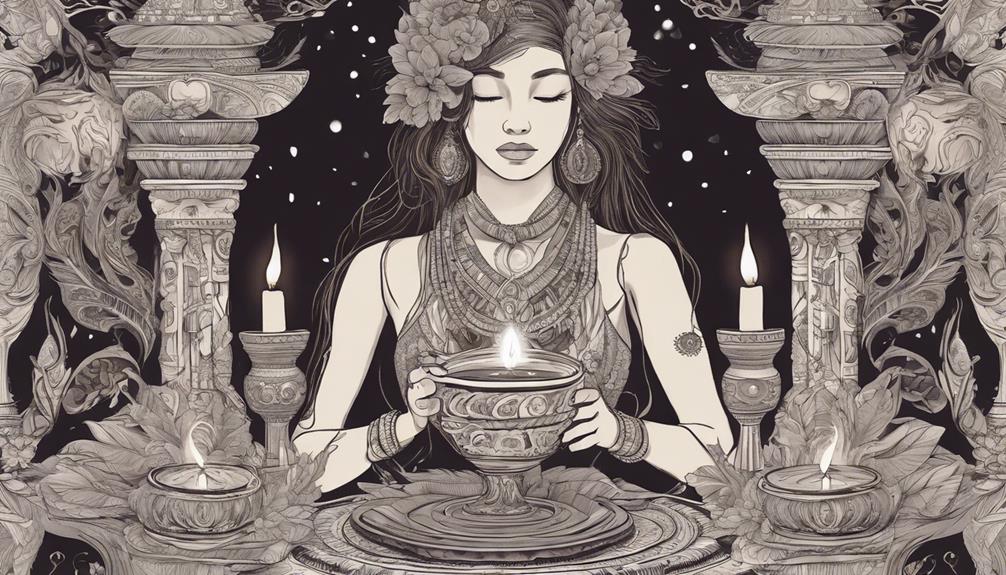
Exploring the realm of sacred cacao through ceremonies reveals a journey filled with ancient traditions and spiritual significance. Participating in cacao rituals has the potential to unlock the heart and strengthen connections with the divine, leading to transformative experiences. Whether it’s uplifting mood and supporting emotional healing or inspiring creativity and mindfulness, cacao holds a central role in ceremonies. Its energetic impact can elevate mood, creativity, and spiritual awareness, providing a gateway to realms where the heart and spirit intersect.
Key Takeaways
- Sacred cacao enhances spiritual connection and facilitates healing in rituals.
- Cacao's compounds promote emotional healing, creativity, and mood enhancement.
- Ceremonial cacao preparation is a sacred act that transcends cultural boundaries.
- Cacao rituals open hearts, boost energy, and deepen sensory experiences.
- Theobromine in cacao fosters mental clarity, focus, and relaxation in rituals.
History of Sacred Cacao Rituals
Sacred cacao rituals trace their origins back to the ancient Mayan and Aztec civilizations, where cacao held a revered status and was integrated into various ceremonial practices. The Mayans and Aztecs viewed cacao not just as a beverage but as a sacred gift from the gods, essential for spiritual practices.
In Mayan culture, cacao was so precious that it was often used as currency. The Aztecs believed that cacao was a divine gift from the god Quetzalcoatl, who brought the cacao tree to humanity. This deep reverence for cacao led to its incorporation into rituals that were central to their societal and spiritual life.
Within these ancestral traditions, cacao played an important role in connecting individuals to the divine, opening their hearts, and fostering a sense of unity and balance. The spiritual practices surrounding cacao were designed to honor the plant's sacred properties and harness its ability to heal and restore. Passed down through generations, these rituals continue to be a significant part of indigenous cultures, emphasizing the profound spiritual significance of cacao in facilitating healing and connection with the divine.
Spiritual Significance of Cacao Ceremonies
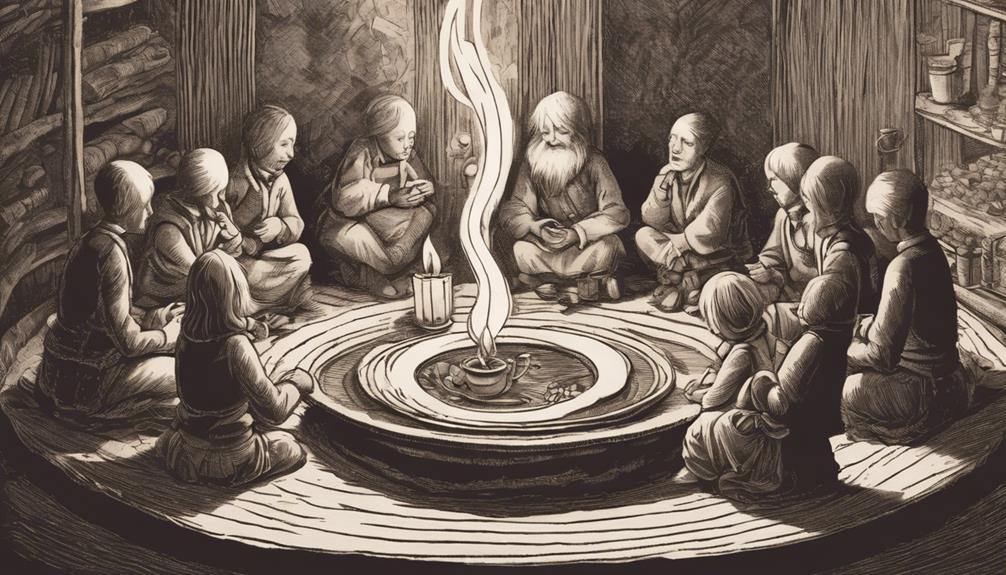
Indigenous communities have preserved the spiritual significance of cacao ceremonies, emphasizing healing and self-discovery through ancient rituals. These ceremonies, rooted in Mayan and Aztec cultures, offer participants a profound journey of introspection and connection with the divine.
In the ceremonial use of cacao, several key elements contribute to its spiritual significance:
- Heart-opening experiences: Cacao's properties in ceremonial settings are known to promote sensations of openness and love, allowing individuals to explore deeply with themselves and others.
- Mood enhancement: The ceremonial consumption of cacao can uplift spirits and create a sense of inner peace and tranquility, fostering a positive emotional state.
- Focus and clarity: Participants often experience heightened focus and mental clarity during cacao ceremonies, enabling them to delve deeper into their thoughts and emotions.
- Healing and transformation: Cacao ceremonies are revered for their ability to facilitate emotional healing, personal growth, and profound transformations within individuals.
Engaging in these ceremonial practices can lead to a transformative and enriching spiritual experience, guiding individuals towards a deeper understanding of themselves and the world around them.
Benefits of Sacred Cacao Consumption
When consuming cacao in ceremonial settings, individuals may experience heart-opening sensations and mood enhancement attributed to specific compounds found in the cacao bean.
Ceremonial cacao contains theobromine, known for its ability to promote emotional healing and amplify feelings of love and connection. Additionally, compounds like anandamide and PEA contribute to the release of neurotransmitters like dopamine and serotonin, fostering a sense of well-being and reducing stress levels. These neurotransmitters are essential for mood enhancement, promoting happiness and relaxation.
Furthermore, the rich antioxidant content in ceremonial cacao supports heart health and aids in tissue repair, contributing to overall well-being. The theobromine present in cacao offers sustained energy without the jitters often associated with caffeine, enhancing focus, creativity, and mental clarity.
Through the consumption of ceremonial cacao, individuals can access a range of benefits that positively impact both their physical and emotional health, making it a valuable addition to rituals and ceremonies.
The Role of Cacao in Healing

In healing practices, cacao plays a significant role due to its rich content of compounds that promote emotional well-being and heart-centered experiences. Ceremonial cacao ceremonies are deeply rooted in creating a healing experience, allowing individuals to explore their emotions on a deeper level and set intentions for their well-being. Here are four ways in which cacao contributes to the healing process:
- Heart-Opening Sensations: Ceremonial cacao has the power to open the heart, allowing individuals to connect with their emotions on a profound level.
- Mood Enhancement: The compounds in cacao, such as theobromine and anandamide, promote mood enhancement, fostering a sense of emotional well-being.
- Intention-Setting: Participants in cacao ceremonies often engage in setting intentions, which serves as a potent tool for focusing their healing journey.
- Emotional Exploration: Through the ritual of ceremonial cacao, individuals can examine their emotions in a safe and supported environment, aiding in their healing process.
Connection Between Cacao and Creativity
Discovering the deep connection between cacao and creativity reveals a world of inspiration and innovation within ceremonial practices. In rituals, cacao has historically been associated with enhancing creativity and unleashing new artistic pathways.
The use of fine-flavor cacao during ceremonies helps to ground the mind, body, and spirit, creating an environment that nurtures creative inspiration. By engaging in cacao ceremonies, individuals aim to establish a profound connection with the spirit of cacao, believed to stimulate and amplify creative energies.
The intentional preparation and consumption of ceremonial cacao can assist individuals in accessing their creative potential and generating fresh ideas. Through the immersive experience of incorporating ceremonial cacao in rituals, individuals can forge a deeper bond with their creativity and inner vision, allowing for the exploration of innovative concepts and artistic expressions.
Embracing the spirit of cacao in ceremonies can be a transformative journey towards harnessing creativity and fostering a deep spiritual connection.
Sacred Cacao Preparation Techniques
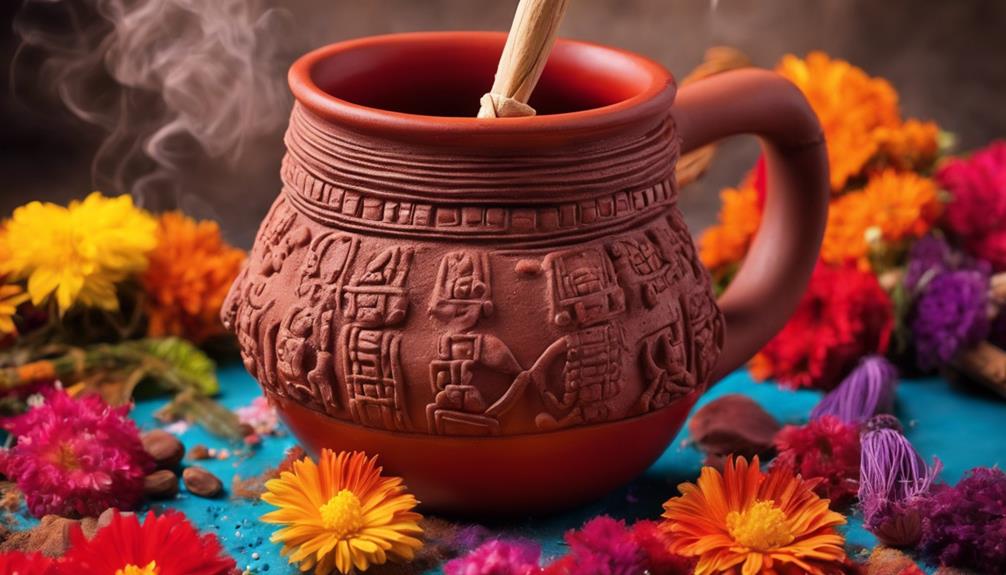
Delving into the intricate process of preparing sacred cacao reveals the profound significance it holds in ceremonial practices. When it comes to the preparation of ceremonial cacao, certain techniques are essential to honor the sacred nature of this ritual. Here are some key points to ponder:
- Grinding Methods: Indigenous communities often employ stone grinding methods to create ceremonial cacao paste. This traditional approach helps preserve the integrity of the cacao beans, ensuring a connection to the earth and the spirit of the cacao.
- Intentional Preparation: The grinding process for ceremonial cacao isn't rushed. It's done slowly and intentionally, allowing for a mindful connection with the cacao's energetic and spiritual properties. This deliberate approach enhances the spiritual essence of the final product.
- Additive-Free Paste: Ceremonial cacao paste is free from additives, retaining the natural richness and nutrients present in the cacao beans. This purity is essential to honor the spirit of cacao and its role in ceremonial rituals.
- Sacred Act: The preparation of ceremonial cacao paste is considered a sacred act, symbolizing respect for the spirit of cacao and the traditions it represents.
Cacao Rituals Across Cultures
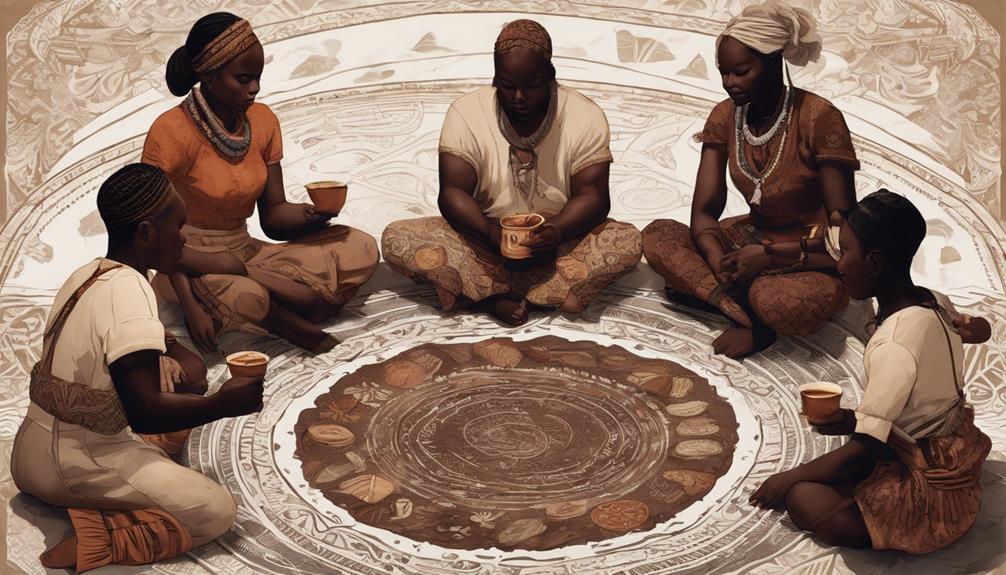
Across diverse cultural landscapes, cacao rituals have transcended boundaries to become revered practices that honor the spirit of this sacred gift. Originating in Mayan and Aztec cultures, cacao was viewed as a divine offering. The Mayans, in particular, incorporated cacao into ceremonies to open hearts and restore balance within their communities. These rituals emphasize gratitude, intention, and reciprocity, fostering a deep connection with the spirit of cacao.
Led by trained facilitators or shamans, traditional cacao ceremonies focus on communal group experiences where individuals come together to partake in the sacred drink. These ceremonies aim to promote inspiration, human connection, and spiritual growth. Through the honoring of cacao and the engagement with its spirit, participants can tap into a profound energy that transcends individual experiences and fosters a sense of unity with the natural world and the Mayan gods associated with this sacred plant.
Cacaos Impact on Mindfulness
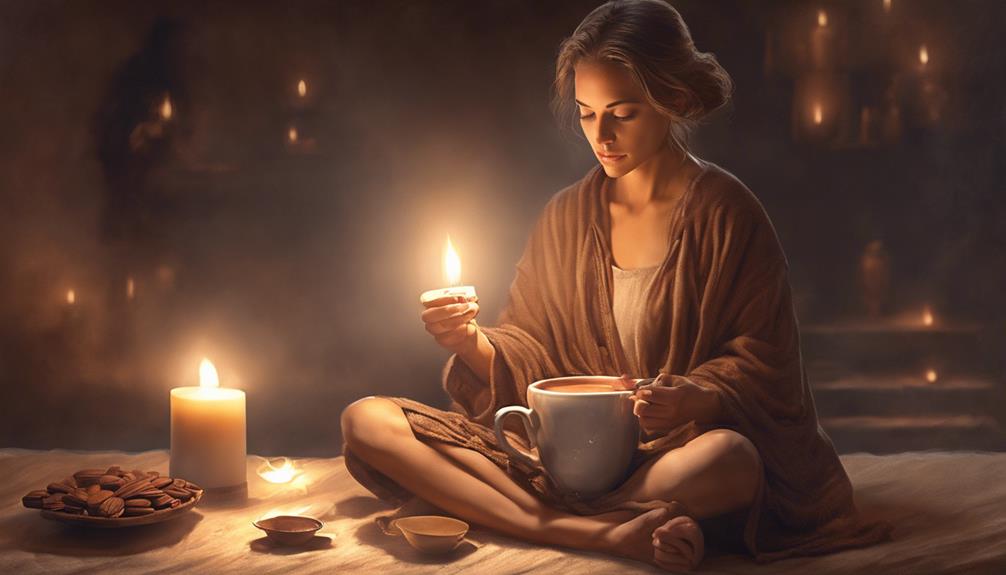
Enhancing mindfulness, ceremonial cacao amplifies the energetic field of the heart, nurturing a profound connection to inner awareness and emotional healing. When consumed in a group setting, cacao's impact on mindfulness intensifies, creating a shared experience that deepens each individual's journey towards self-discovery.
The following aspects highlight cacao's influence on mindfulness during a cacao ceremony:
- Heightened Clarity: Cacao facilitates mental clarity, allowing for a sharper focus on the present moment.
- Inspiration: The properties of cacao inspire creativity and encourage a fresh perspective on one's emotions and thoughts.
- Deeper Sensory Experiences: Engaging with cacao enhances sensory perceptions, making each moment more vivid and engaging.
- Presence: Participating in a cacao ceremony promotes a profound sense of presence, grounding individuals in the now and fostering a deeper connection with themselves and others.
Through the subtle yet potent effects of cacao, mindfulness flourishes, enriching the overall experience of rituals and inner exploration.
Enhancing Meditation With Cacao

When meditating, using cacao can help enhance focus and relaxation.
The theobromine in cacao promotes a calm and alert state of mind, perfect for deep meditation sessions.
Incorporating cacao into your meditation rituals can create a more profound and intentional space for inner exploration.
Cacao for Focus
Incorporating cacao into meditation practices can greatly enhance focus and mental clarity. When I sip on ceremonial cacao before meditating, I notice a significant improvement in my ability to stay present and attentive. Here are some ways that cacao can help you focus during your meditation sessions:
- The theobromine in cacao boosts mental clarity.
- Phenylethylamine triggers dopamine release, promoting a positive mindset.
- Cacao's nutrients support cognitive function for deeper meditation.
- Consuming cacao prior to meditation can enhance creativity and the overall experience.
With its mood-enhancing properties, cacao creates an ideal environment for productive and focused meditation.
Cacao for Relaxation
Cacao's calming effects enhance relaxation and deepen the meditative experience. During meditation, ceremonial cacao can help quiet the mind and soothe the body, creating a tranquil space for inner reflection.
The theobromine found in cacao promotes a sense of tranquility, allowing for a deeper connection to your spiritual self. By incorporating cacao into your mindfulness practice, you can enhance your ability to stay present and focused.
This heart-opening elixir not only aids in relaxation but also in creating a serene environment for meditation. Drinking ceremonial cacao can promote a heightened sense of awareness, making it easier to connect with your inner self and the world around you.
Cacaos Energetic Influence
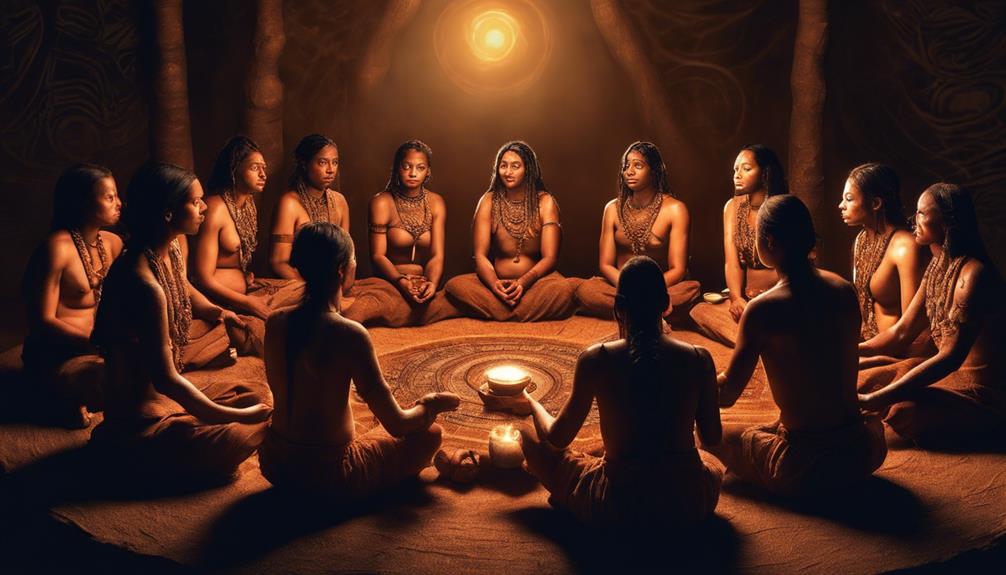
Energizing and heart-opening, ceremonial cacao's influence in rituals enhances emotional connections through its ability to stimulate the heart chakra and promote feelings of love and compassion. The theobromine present in cacao acts as a gentle heart stimulant, fostering a sense of connection and empathy among participants.
In group settings, the energetic effects of cacao are heightened, creating a shared experience that deepens emotional bonds. Additionally, cacao's compounds can enhance mood, creativity, and spiritual awareness, making it a powerful tool for emotional healing and personal growth.
- Cacao's energetic influence opens the heart chakra, enhancing emotional connections.
- The theobromine in cacao acts as a gentle heart stimulant, promoting love and compassion.
- Neurotransmitter-boosting compounds in cacao enhance mood, creativity, and spiritual awareness.
- Participants in cacao ceremonies often report increased energy, focus, and emotional healing.
Frequently Asked Questions
What Does Cacao Do for You Spiritually?
Cacao spiritually uplifts me by opening my heart, enhancing my mood, and facilitating emotional exploration. Its compounds like theobromine and anandamide promote focus and a deeper connection to my inner self.
Why Was Chocolate Used in Rituals?
Using chocolate in rituals was about connecting deeply with tradition, honoring life's pivotal moments. Grounding mind, body, spirit. Chocolate symbolized unity, celebration, strength. It brought people together, marking births, marriages, battles.
What Is the Power of Cacao?
The power of cacao lies in its ability to open my heart, enhance mood, and promote emotional healing. Its compounds like theobromine and anandamide boost focus. Cacao ceremonies connect me spiritually, inviting transformative experiences.
What Is the Religious Significance of Cacao?
The religious significance of cacao lies in its role as a divine gift, fostering connection with the sacred. Mayan and Aztec cultures revered cacao as a symbol of unity and divine creation, honoring its spiritual essence.
How Does Sacred Cacao Play a Role in Rituals and Ceremonies?
In many cultures, the sacred cacao ceremony essence holds a significant role in traditional rituals and ceremonies. The preparation and consumption of cacao are seen as a spiritual experience, bringing people together and fostering a deeper connection with oneself and the divine. The sacred cacao ceremony essence helps facilitate introspection and healing.
Conclusion
To sum up, the power of sacred cacao in rituals is truly remarkable. As the saying goes, 'Where there's cacao, there's magic.'
From its rich history to its spiritual significance, cacao ceremonies offer a unique way to connect with oneself and the world around us.
Whether consumed for healing, creativity, or mindfulness, cacao has a profound impact on our well-being and inner growth.
So next time you sip on a cup of cacao, remember the sacredness and magic it holds.
Rachael, the Editor in Chief of RachaelsRawFood.com, is an inspiring and passionate individual who has dedicated her life to promoting the benefits of a raw food lifestyle. Known for her vibrant and energetic personality, Rachael has built a strong online presence that has transformed her personal journey into a thriving community of raw food enthusiasts.
-

 Raw Food Ingredients1 month ago
Raw Food Ingredients1 month agoHow To Make Hot Chocolate With Raw Cacao Powder
-

 Raw Food Ingredients1 month ago
Raw Food Ingredients1 month agoHow To Make Chocolate From Raw Cacao
-

 Raw Food Ingredients1 month ago
Raw Food Ingredients1 month agoHow To Prepare Raw Cacao Drink
-

 Raw Food Ingredients1 month ago
Raw Food Ingredients1 month agoHow Much Raw Cacao Per Day For Full Benefits
-
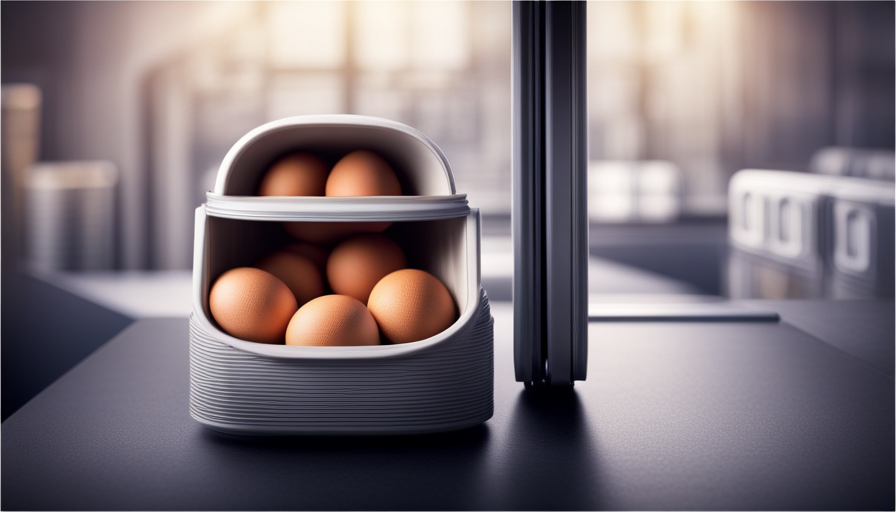
 What is Raw Food?2 months ago
What is Raw Food?2 months agoHow Long Should Uncooked Food With Raw Egg Be In The Refrigerator
-

 Raw Food Ingredients7 days ago
Raw Food Ingredients7 days agoRaw Cacao Powder How Much For 8 Oz Hot Chocolate Recipe
-

 Raw Food Ingredients4 weeks ago
Raw Food Ingredients4 weeks agoWhen Fasting Can I Drink Coffee With Raw Cacao Powder
-

 Raw Food Ingredients1 month ago
Raw Food Ingredients1 month agoHow Much Caffeine Is In Raw Cacao Powder






